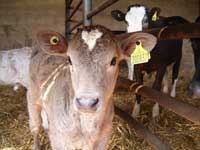Vet Watch: Update of animal health issues from across the country

A regional round-up of key veterinary issues from membersof XLVets
Toby Kemble, Wensum Valley Vets Surgery, Fakenham, Norfolk
Winter housing is upon us, resulting in a rise of calf pneumonia cases. The cause is usually a combination of infectious agents such as bacteria and viruses, the immune/vaccination status of the calf and often, more importantly, ventilation.
Fresh air should enter buildings at the eaves and leave by the ridge and, when this isn’t the case, more pneumonia cases will be seen.
Rather than spending money on treatment, it may be more cost effective getting the vet and local builder together and discussing how buildings can be adapted to improve air flows.
Bridget Taylor, Wright and Morten, Macclesfield, Cheshire
Autumn is a busy time for carrying out pregnancy diagnosis in spring block calving dairy herds.
We have found the percentage of empty cows at the end of a service block is the most useful fertility parameter, with the percentage ranging from 5% to 25% across our region.
Areas for improvement we have suggested include: checking cows for whites before serving; applying tail paint for three weeks before the planned start of mating; and getting the vet to look at all cows not bulling before the start of mating and not served in the first three weeks.
Also, checking bull fertility and protection of heifers and cows against leptospirosis and BVD is vital.
Liz Bennett, Larkmead Vet Group, Cholsey, Oxfordshire
Winter chilling in outdoor farrowing systems is a concern, with piglets particularly susceptible to cold; this not only increases pre-weaning mortality and disease susceptibility, but reduces weight gain.
Choosing a suitable site for farrowing paddocks in winter is important. Natural shelter, correct stocking density and well-drained soil are essential, with huts positioned with backs to the prevailing wind.
Straw depth inside huts can affect sow movement, a reduction in which can increase overlaying. A dry lying area is essential and, in wet conditions, bedding in huts can be protected by use of a “straw doormat” outside the hut.
Andrew Crutchley, Bishopton Veterinary Group, Ripon, North Yorkshire
Recent fine weather means cattle have been out longer than usual and we are already seeing clinical fluke cases in adult dairy and beef cattle.
Controlling fluke is becoming challenging and ensuring the products used for treatment and control target the relevant life stages is vitally important.
We have been busy with the XL Vets FarmSkills programme. We’re fortunate to work with some great famers in the north east and it’s encouraging to see their enthusiasm.
